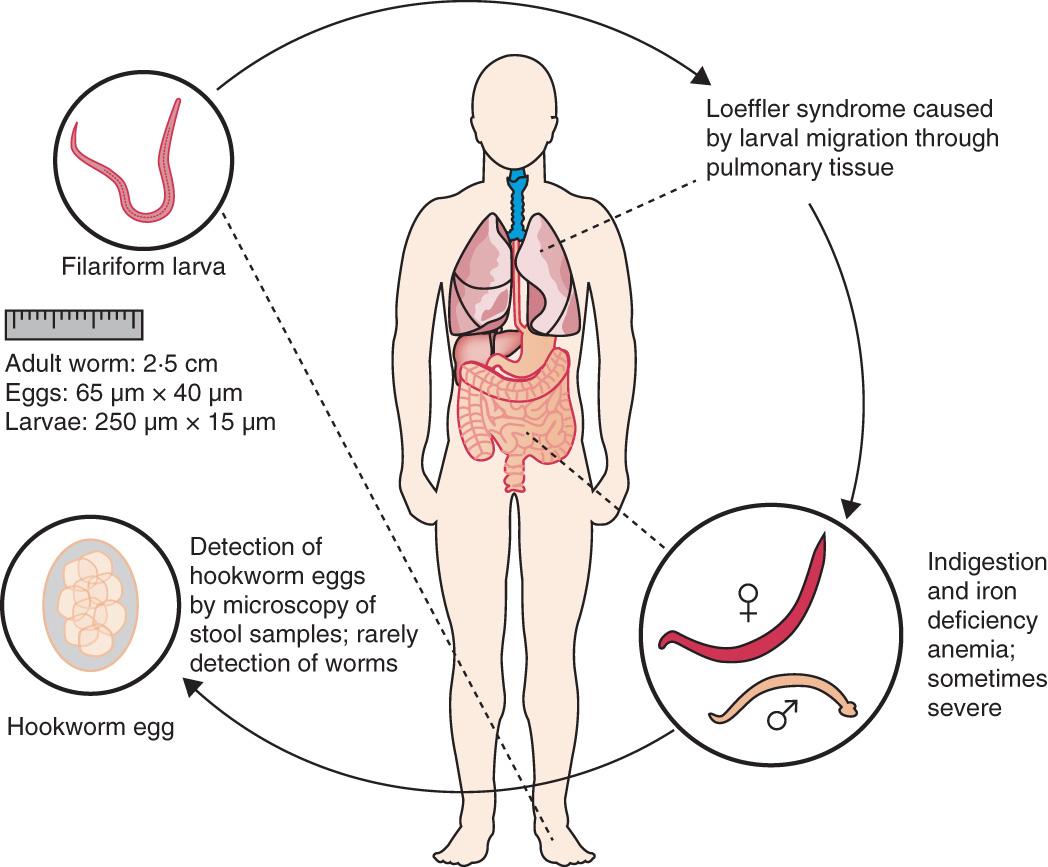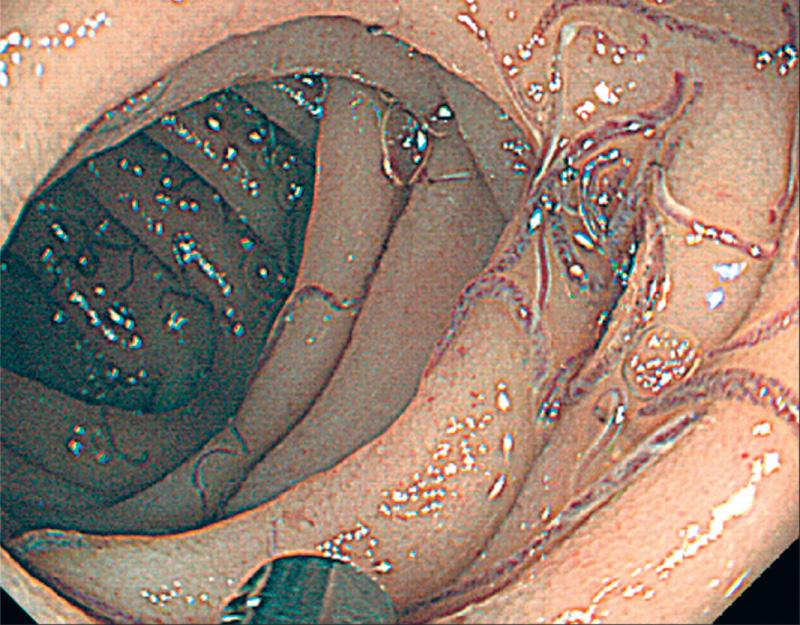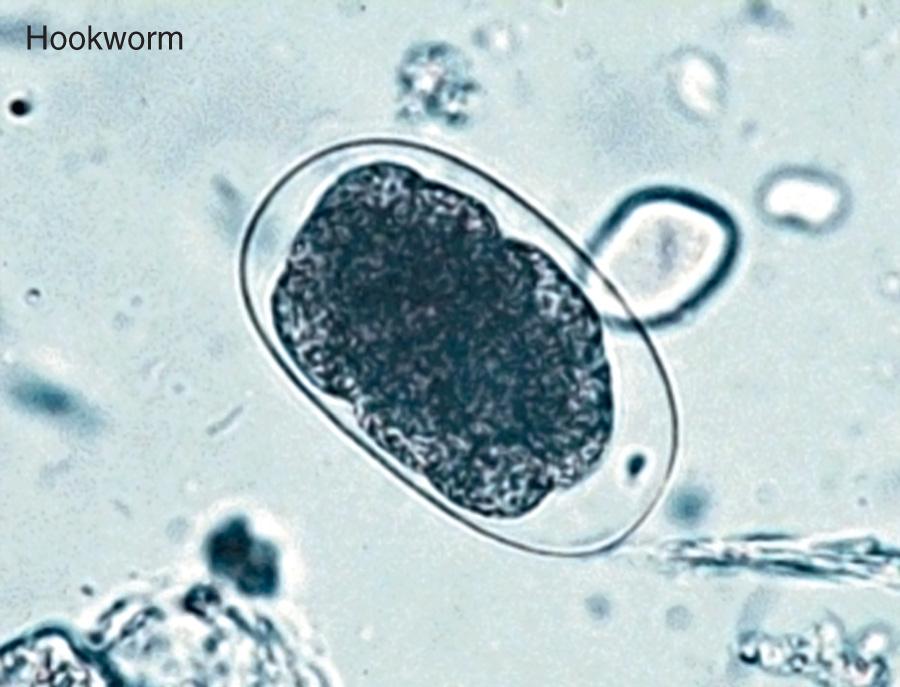Physical Address
304 North Cardinal St.
Dorchester Center, MA 02124
Two major genera of hookworms, which are nematodes, or roundworms, infect humans. Necator americanus, the only representative of its genus, is a major anthropophilic hookworm and is the most common cause of human hookworm infection. Hookworms of the genus Ancylostoma include the anthropophilic hookworm Ancylostoma duodenale, which also causes classic hookworm infection, and the less common zoonotic species Ancylostoma ceylanicum (restricted mostly to Southeast Asia). Human zoonotic infection with the dog hookworm Ancylostoma caninum is associated with an eosinophilic enteritis syndrome. The larval stage of Ancylostoma braziliense, whose definitive hosts include dogs and cats, is the principal cause of cutaneous larva migrans.
The infective larval stages of the anthropophilic hookworms live in a developmentally arrested state in warm, moist soil. Larvae infect humans either by penetrating through the skin ( N. americanus and A. duodenale ) or when they are ingested (A. duodenale). Larvae entering the human host by skin penetration undergo extraintestinal migration through the venous circulation and lungs before they are swallowed, whereas orally ingested larvae may undergo extraintestinal migration or remain in the gastrointestinal (GI) tract ( Figs. 318.1 and 318.2 ). Larvae returning to the small intestine undergo 2 molts to become adult, sexually mature, male and female worms ranging in length from 5-13 mm. The buccal capsule of the adult hookworm is armed with cutting plates (N. americanus) or teeth (A. duodenale) to facilitate attachment to the mucosa and submucosa of the small intestine. Hookworms can remain in the intestine for 1-5 yr, where they mate and produce eggs. Although up to 2 mo is required for the larval stages of hookworms to undergo extraintestinal migration and develop into mature adults, A. duodenale larvae may remain developmentally arrested for many months before resuming development in the intestine. Mature A. duodenale female worms produce about 30,000 eggs per day; daily egg production by N. americanus is <10,000/day ( Fig. 318.3 ). The eggs are thin shelled and ovoid, measuring approximately 40-60 µm. Eggs that are deposited on soil with adequate moisture and shade develop into first-stage larvae and hatch. Over the ensuing several days and under appropriate conditions, the larvae molt twice to the infective stage. Infective larvae are developmentally arrested and nonfeeding. They migrate vertically in the soil until they either infect a new host or exhaust their lipid metabolic reserves and die.



Hookworm infection is one of the most prevalent infectious diseases of humans. The Global Burden of Disease Study 2015 reported that approximately 428 million people are infected with hookworms, with further estimates indicating that hookworm infection globally results in 4.1 million disability-adjusted life-years, possibly leading all neglected tropical diseases in years lost through disability. In the case of hookworm infection, all the years lost through disability are attributed to anemia from intestinal blood loss. There is also a massive socioeconomic impact from hookworm infection, with estimates that hookworm can cause up to $139 billion in losses from diminished productivity.
Because of the requirement for adequate soil moisture, shade, and warmth, hookworm infection is usually confined to rural areas, especially where human feces are used for fertilizer or where sanitation is inadequate. Hookworm is an infection associated with economic underdevelopment and poverty throughout the tropics and subtropics. Sub-Saharan Africa, East Asia, and tropical regions of the Americas have the highest prevalence of hookworm infection. High rates of infection are often associated with cultivation of certain agricultural products, such as tea in India; sweet potato, corn, cotton, and mulberry trees in China; coffee in Central and South America; and rubber in Africa. It is not uncommon to find dual N. americanus and A. duodenale infections. N. americanus predominates in Central and South America as well as in southern China and Southeast Asia, whereas A. duodenale predominates in North Africa, in northern India, in China north of the Yangtze River, and among aboriginal people in Australia. The ability of A. duodenale to withstand somewhat harsher environmental and climatic conditions may reflect its ability to undergo arrested development in human tissues. A. ceylanicum infection occurs in India and Southeast Asia.
Eosinophilic enteritis caused by A. caninum was first described in Queensland, Australia, with 2 reported cases in the United States. Because of its global distribution in dogs, it was initially anticipated that human A. caninum infections would be identified in many locales, but this has not been found.
The major morbidity of human hookworm infection is a direct result of intestinal blood loss . Adult hookworms adhere tenaciously to the mucosa and submucosa of the proximal small intestine by using their cutting plates or teeth and a muscular esophagus that creates negative pressure in their buccal capsules. At the attachment site, host inflammation is downregulated by the release of antiinflammatory polypeptides by the hookworm. Rupture of capillaries in the lamina propria is followed by blood extravasation, with some of the blood ingested directly by the hookworm. After ingestion, the blood is anticoagulated, the red blood cells are lysed, and the hemoglobin released and digested. Each adult A. duodenale hookworm causes loss of an estimated 0.2 mL of blood/day; blood loss is less for N. americanus. Individuals with light infections have minimal blood loss and thus may have hookworm infection but not hookworm disease. There is a direct correlation between the number of adult hookworms in the gut and the volume of fecal blood loss. Hookworm disease results only when individuals with moderate and heavy infections experience sufficient blood loss to develop iron deficiency and anemia. Hypoalbuminemia and consequent edema and anasarca from the loss of intravascular oncotic pressure can also occur. These features depend heavily on the dietary reserves of the host.
Chronically infected children with moderate and heavy hookworm infections suffer from intestinal blood loss that results in iron deficiency and can lead to anemia as well as protein malnutrition. Prolonged iron deficiency associated with hookworms in childhood can lead to physical growth retardation and cognitive and intellectual deficits.
Anthropophilic hookworm larvae elicit dermatitis sometimes referred to as ground itch when they penetrate human skin. The vesiculation and edema of ground itch are exacerbated by repeated infection. Infection with a zoonotic hookworm, especially A. braziliense, can result in lateral migration of the larvae to cause the characteristic cutaneous tracts of cutaneous larva migrans (see Chapter 318.1 ). Cough subsequently occurs in A. duodenale and N. americanus hookworm infection when larvae migrate through the lungs to cause laryngotracheobronchitis, usually about 1 wk after exposure. Pharyngitis also can occur. The onset of eosinophilia coincides with the entry of hookworm larvae into the GI tract. Upper abdominal pain can occur during this period, but it eventually subsides.
Chronic intestinal hookworm infection is not typically associated with specific GI complaints, although pain, anorexia, and diarrhea have been attributed to the presence of hookworms. The major clinical manifestations are related to intestinal blood loss. Heavily infected children exhibit all the signs and symptoms of iron-deficiency anemia and protein malnutrition . In some cases, children with chronic hookworm disease acquire a yellow-green pallor known as chlorosis.
An infantile form of ancylostomiasis resulting from heavy A. duodenale infection has been described. Affected infants experience diarrhea, melena, failure to thrive, and profound anemia. Infantile ancylostomiasis has significant mortality.
Eosinophilic enteritis caused by A. caninum is associated with colicky abdominal pain that begins in the epigastrium and radiates outward and is usually exacerbated by food. Extreme cases may mimic acute appendicitis.
Children with hookworm release eggs that can be detected by direct fecal examination (see Fig. 318.3 ). Quantitative methods are available to determine whether a child has a heavy worm burden that can cause hookworm disease. The eggs of N. americanus and A. duodenale are morphologically indistinguishable. Species identification typically requires egg hatching and differentiation of third-stage infective larvae; methods using polymerase chain reaction (PCR) methods have been developed but are not generally used in clinical practice.
In contrast, eggs are generally not present in the feces of patients with eosinophilic enteritis caused by A. caninum. Eosinophilic enteritis is often diagnosed by demonstrating ileal and colonic ulcerations by colonoscopy in the presence of significant blood eosinophilia. An adult canine hookworm may occasionally be recovered during colonoscopic biopsy. Patients with this syndrome develop IgG and IgE serologic responses.
Become a Clinical Tree membership for Full access and enjoy Unlimited articles
If you are a member. Log in here